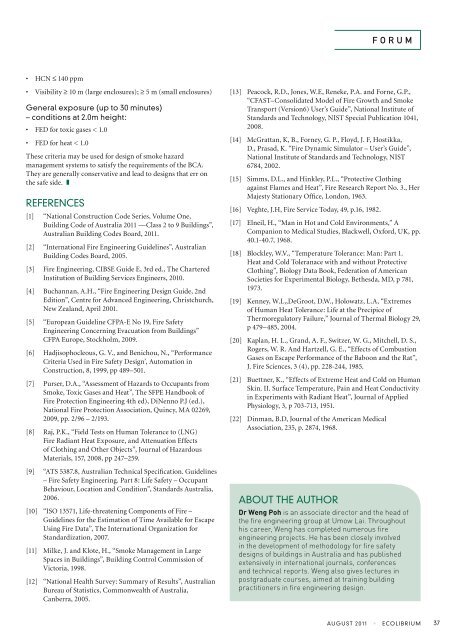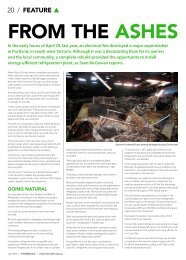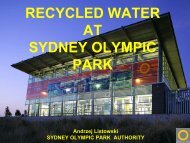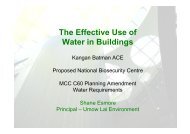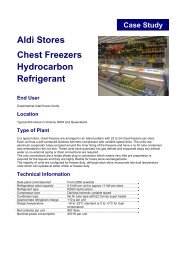Tenability criteria for design of smoke hazard management ... - Airah
Tenability criteria for design of smoke hazard management ... - Airah
Tenability criteria for design of smoke hazard management ... - Airah
Create successful ePaper yourself
Turn your PDF publications into a flip-book with our unique Google optimized e-Paper software.
• HCN ≤ 140 ppm<br />
• Visibility ≥ 10 m (large enclosures); ≥ 5 m (small enclosures)<br />
general exposure (up to 30 minutes)<br />
– conditions at 2.0m height:<br />
• FED <strong>for</strong> toxic gases < 1.0<br />
• FED <strong>for</strong> heat < 1.0<br />
These <strong>criteria</strong> may be used <strong>for</strong> <strong>design</strong> <strong>of</strong> <strong>smoke</strong> <strong>hazard</strong><br />
<strong>management</strong> systems to satisfy the requirements <strong>of</strong> the BCA.<br />
They are generally conservative and lead to <strong>design</strong>s that err on<br />
the safe side. ❚<br />
RefeReNCeS<br />
[1] “National Construction Code Series, Volume One,<br />
Building Code <strong>of</strong> Australia 2011 —Class 2 to 9 Buildings”,<br />
Australian Building Codes Board, 2011.<br />
[2] “International Fire Engineering Guidelines”, Australian<br />
Building Codes Board, 2005.<br />
[3] Fire Engineering, CIBSE Guide E, 3rd ed., The Chartered<br />
Institution <strong>of</strong> Building Services Engineers, 2010.<br />
[4] Buchannan, A.H., “Fire Engineering Design Guide, 2nd<br />
Edition”, Centre <strong>for</strong> Advanced Engineering, Christchurch,<br />
New Zealand, April 2001.<br />
[5] “European Guideline CFPA-E No 19, Fire Safety<br />
Engineering Concerning Evacuation from Buildings”<br />
CFPA Europe, Stockholm, 2009.<br />
[6] Hadjisophocleous, G. V., and Benichou, N., “Per<strong>for</strong>mance<br />
Criteria Used in Fire Safety Design’, Automation in<br />
Construction, 8, 1999, pp 489–501.<br />
[7] Purser, D.A., “Assessment <strong>of</strong> Hazards to Occupants from<br />
Smoke, Toxic Gases and Heat”, The SFPE Handbook <strong>of</strong><br />
Fire Protection Engineering 4th ed), DiNenno P.J (ed.),<br />
National Fire Protection Association, Quincy, MA 02269,<br />
2009, pp. 2/96 – 2/193.<br />
[8] Raj, P.K., “Field Tests on Human Tolerance to (LNG)<br />
Fire Radiant Heat Exposure, and Attenuation Effects<br />
<strong>of</strong> Clothing and Other Objects”, Journal <strong>of</strong> Hazardous<br />
Materials, 157, 2008, pp 247–259.<br />
[9] “ATS 5387.8, Australian Technical Specification. Guidelines<br />
– Fire Safety Engineering. Part 8: Life Safety – Occupant<br />
Behaviour, Location and Condition”, Standards Australia,<br />
2006.<br />
[10] “ISO 13571, Life-threatening Components <strong>of</strong> Fire –<br />
Guidelines <strong>for</strong> the Estimation <strong>of</strong> Time Available <strong>for</strong> Escape<br />
Using Fire Data”, The International Organization <strong>for</strong><br />
Standardization, 2007.<br />
[11] Milke, J. and Klote, H., “Smoke Management in Large<br />
Spaces in Buildings”, Building Control Commission <strong>of</strong><br />
Victoria, 1998.<br />
[12] “National Health Survey: Summary <strong>of</strong> Results”, Australian<br />
Bureau <strong>of</strong> Statistics, Commonwealth <strong>of</strong> Australia,<br />
Canberra, 2005.<br />
FORUM<br />
[13] Peacock, R.D., Jones, W.E, Reneke, P.A. and Forne, G.P.,<br />
“CFAST–Consolidated Model <strong>of</strong> Fire Growth and Smoke<br />
Transport (Version6) User’s Guide”, National Institute <strong>of</strong><br />
Standards and Technology, NIST Special Publication 1041,<br />
2008.<br />
[14] McGrattan, K, B., Forney, G. P., Floyd, J. F, Hostikka,<br />
D., Prasad, K. “Fire Dynamic Simulator – User’s Guide”,<br />
National Institute <strong>of</strong> Standards and Technology, NIST<br />
6784, 2002.<br />
[15] Simms, D.L., and Hinkley, P.L., “Protective Clothing<br />
against Flames and Heat”, Fire Research Report No. 3., Her<br />
Majesty Stationary Office, London, 1963.<br />
[16] Veghte, J.H, Fire Service Today, 49, p.16, 1982.<br />
[17] Elneil, H., “Man in Hot and Cold Environments,” A<br />
Companion to Medical Studies, Blackwell, Ox<strong>for</strong>d, UK, pp.<br />
40.1-40.7, 1968.<br />
[18] Blockley, W.V., “Temperature Tolerance: Man: Part 1.<br />
Heat and Cold Toleranace with and without Protective<br />
Clothing”, Biology Data Book, Federation <strong>of</strong> American<br />
Societies <strong>for</strong> Experimental Biology, Bethesda, MD, p 781,<br />
1973.<br />
[19] Kenney, W.L,,DeGroot, D.W., Holowatz, L.A, “Extremes<br />
<strong>of</strong> Human Heat Tolerance: Life at the Precipice <strong>of</strong><br />
Thermoregulatory Failure,” Journal <strong>of</strong> Thermal Biology 29,<br />
p 479–485, 2004.<br />
[20] Kaplan, H. L., Grand, A. F., Switzer, W. G., Mitchell, D. S.,<br />
Rogers, W. R. And Hartzell, G. E., “Effects <strong>of</strong> Combustion<br />
Gases on Escape Per<strong>for</strong>mance <strong>of</strong> the Baboon and the Rat”,<br />
J. Fire Sciences, 3 (4), pp. 228-244, 1985.<br />
[21] Buettner, K., “Effects <strong>of</strong> Extreme Heat and Cold on Human<br />
Skin. II. Surface Temperature, Pain and Heat Conductivity<br />
in Experiments with Radiant Heat”, Journal <strong>of</strong> Applied<br />
Physiology, 3, p 703-713, 1951.<br />
[22] Dinman, B.D, Journal <strong>of</strong> the American Medical<br />
Association, 235, p. 2874, 1968.<br />
About tHe AutHoR<br />
Dr Weng Poh is an associate director and the head <strong>of</strong><br />
the fire engineering group at umow Lai. Throughout<br />
his career, Weng has completed numerous fire<br />
engineering projects. He has been closely involved<br />
in the development <strong>of</strong> methodology <strong>for</strong> fire safety<br />
<strong>design</strong>s <strong>of</strong> buildings in Australia and has published<br />
extensively in international journals, conferences<br />
and technical reports. Weng also gives lectures in<br />
postgraduate courses, aimed at training building<br />
practitioners in fire engineering <strong>design</strong>.<br />
AuguSt 2011 • eColibRiuM<br />
37


